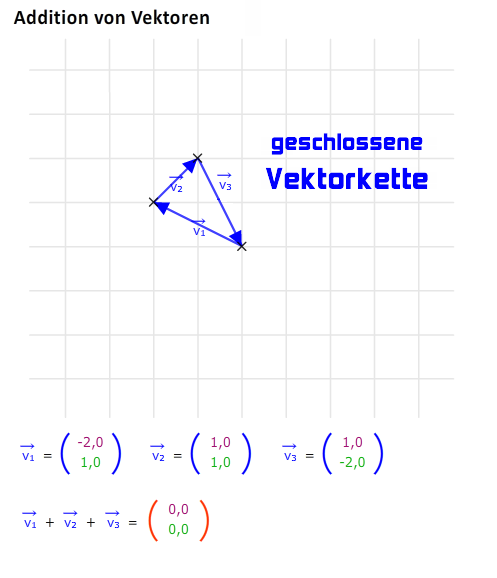CHECK: Vektoraddition II
Um diese Seite nutzen zu können, musst du eingeloggt sein. – Neu hier? Dann registriere dich.
Addiere die beiden Vektoren im Raum.
\( \vec{c} = \begin{pmatrix} 5 \\ -a \\ 10 \end{pmatrix} \text{ und } \vec{d} = \begin{pmatrix} -6 \\ b \\ 3 \end{pmatrix} \)
\( \begin{pmatrix} 5-6 \\ -a+b \\ 10+3 \end{pmatrix}= \begin{pmatrix} -1 \\ -a+b \\ 13 \end{pmatrix} \)
Welche Werte müssen x und y haben, damit diese Vektoraddition aufgeht?
\( \begin{pmatrix} 5 \\ x \\ -3 \end{pmatrix} + \begin{pmatrix} 5 \\ 2 \\ y \end{pmatrix} = \begin{pmatrix} 10 \\ 7\\ 0 \end{pmatrix} \)
Wir erhalten für x die Gleichung: x + 2 = 7, damit x = 5.
Wir erhalten für x die Gleichung: -3 + y = 0, damit y = 3.
Welche Werte muss man für x,y,z einsetzen, damit diese Vektoraddition richtig ist?
\( \begin{pmatrix} x \\ -5 \\ 12 \end{pmatrix} + \begin{pmatrix} 15 \\ y \\ 4 \end{pmatrix} = \begin{pmatrix} 29 \\ 9\\ z \end{pmatrix} \)
Wir erhalten drei Gleichungen:
x + 15 = 29 → x = 14
-5 + y = 9 → y = 14
12 + 4 = z → z = 16
Was erhält man, wenn man zwei Vektoren addiert, die genau in die entgegengesetze Richtung zeigen und gleich lang sind?
Beispiel:
\( \begin{pmatrix} -a\\ b \\ c \end{pmatrix} + \begin{pmatrix} a \\ -b \\ -c \end{pmatrix} = \begin{pmatrix} -a + a \\ b - b \\ c - c \end{pmatrix} = \begin{pmatrix} 0 \\ 0 \\ 0 \end{pmatrix} \)
Addiere die beiden Vektoren.
\( \begin{pmatrix} 5a \\ 6b \\ 3c \end{pmatrix} + \begin{pmatrix} -4a \\ 5b \\ -3c \end{pmatrix} = \)
\( \begin{pmatrix} 5a-4a \\ 6b+5b \\ 3c-3c \end{pmatrix} = \begin{pmatrix} a \\ 11b \\ 0 \end{pmatrix} \)
Was ist eine geschlossene Vektorkette?

Fortschritt:
